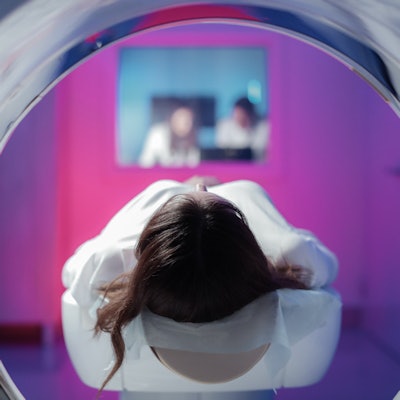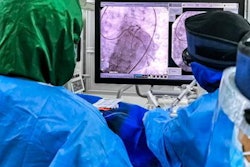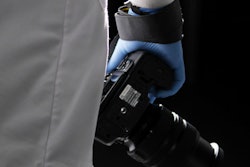
A 43-year-old patient's fatal reaction to CT contrast after a wellness scan in 2019 has generated intense debate of preventative measures and patient safety, but more discussion of regulatory implementation is urgently needed, according to chief physicist and radiation safety officer Zoe Brady, PhD, from the Alfred Hospital in Melbourne.
 Zoe Brady, PhD.
Zoe Brady, PhD."This was an extremely unfortunate incident, but it shines a spotlight on one of the tenets of radiation protection: justification," Brady noted. "Justification is probably the more challenging radiation protection principle to explain and understand in practice."
People working in medical imaging have a good appreciation of the optimization of doses and image quality and dose limitation as it relates to occupational exposures. "Our work procedures reflect the regulatory requirements, but implementation can often be complex," she explained.
Brady's recent talk at the annual scientific meeting of Royal Australian and New Zealand College of Radiologists (RANZCR) in Adelaide addressed the justification issue rather than the anaphylactic reaction. It was based on the Victorian regulatory requirements (Victorian Radiation Act 2005) for CT scans and a review of the coroner's case, which stated that it is not uncommon that referring practitioners do not provide all the required components for an adequate referral.
As a result, a number of recommendations from coroner Simon McGregor concern inappropriate requests, she told AuntMinnieEurope.com.
Circumstances of patient death
Peta Hickey's voluntary health check on 1 May 2019 was suggested by her employer, Programmed Skilled Workforce Limited, as part of the company's testing regime for all senior staff after a colleague suffered a near-fatal cardiac arrest in 2018.
The mother-of-two had no history of heart problems, but she had an anaphylactic reaction to contrast injected as part of the CT coronary angiogram and she died in hospital eight days later. She had never met or spoken to the doctor, Dr. Doumit Saad, who allowed his electronic signature to be inserted into her referral by a corporate booking service, Priority Care Health Solutions. Medical imaging booking service, MRI Now, used the referral to send Hickey to Future Medical Imaging Group (FMIG) in Moonee Ponds for the CT scan.
A radiographer administered the intravenous contrast medium, and radiologist Dr. Gavin Tseng was responsible overall. Tseng did not see the patient until after she collapsed.
 Dr. Gavin Tseng. Photo courtesy of Paul Jeffers.
Dr. Gavin Tseng. Photo courtesy of Paul Jeffers.According to media reports, Tseng stated he didn't give her potentially life-saving adrenaline, claiming he couldn't do two things at once. During the inquest, it was noted that Tseng had only received general anaphylaxis training and was not aware of any resuscitation instructions being displayed at the clinic.
Two teams of paramedics attended the patient, only the second crew administering the adrenaline, but Hickey suffered multiple organ failure. A postmortem revealed a normal heart and coronary artery and no evidence to suggest a history of symptoms or signs relating to cardiovascular disease.
Systemic failures
So how did deviation from procedure fail the patient?
The request for the cardiac CT scan and coronary artery calcium scoring was received by a private imaging practice, but the request did not have any clinical notes or indication for the scan, Brady said. The scan was still performed despite the workplace Radiation Management Plan, which states that without clinical information a request must not be accepted.
Furthermore, the coroner considered that the referrals from this workplace assessment program were in fact a snapshot test of Australia's system of private diagnostic imaging practices, she added. Because the management staff of the company who underwent the cardiac CT scans were located around Australia, these imaging requests went to an almost random selection of practices nationwide.
Of the 26 referrals, all had insufficient clinical details and follow-up contact information, yet every scan was performed. The coroner commented that "checks and balances the industry believed were present failed."
Vital education
In its response, RANZCR noted that it has robust standards and guidelines for clinical radiology practice, and it has developed the Iodinated Contrast Media Guideline for clinical radiologists and other healthcare professionals involved in the administration of iodinated contrast media to ensure patient safety.
Also, the College has updated the continuing professional development (CPD) requirements starting from January 2023 to clarify that all clinical radiologists are required to complete anaphylaxis training once every three years to maintain skills in the management of anaphylactic reactions and record such training in their CPD ePortfolio.
Furthermore, the Victoria Department of Health, the local radiation regulator, has conducted onsite inspections of practices where cardiac CT scans are performed to assess the processes for justification and approval of these scans, according to Brady.
In relation to understanding the legal requirements of justification, ongoing education such as this type of case review is provided to radiologists at Alfred Hospital, she said. Furthermore, she has highlighted the issue at hospital level so that clinicians requesting CT scans have an understanding of the issues. This move has also added to discussion around the use of a clinical decision-support tool and evidence-based referrals within the hospital.
She noted that such case reviews were useful for assessing what changes can be made at a practice level as this provides an opportunity and contemporary context for radiologist education and a refreshing of knowledge around the radiologist's responsibilities when justifying and approving CT scans or other diagnostic imaging that involves ionising radiation exposure.
Golden rules
Brady stated that where individual justification of a CT scan is required, the radiologist must determine if there is a net benefit from the radiation procedure by taking into account the following:
- The specific objectives of the procedure
- The characteristics of the individual patient involved
- The total potential clinical benefits, including the direct health benefits to the patient and, where relevant, the benefits to society in general
- The individual detriment to the patient that may result from the procedure
- The pregnancy status of a patient of child-bearing capacity
- The efficacy, benefits and risks of available alternate techniques having the same objectives with less or no exposure to ionising radiation
- Any available medical data and patient records relevant to the medical exposure
These requirements are stated in the ARPANSA Code for Radiation Protection in Medical Exposure, RPS C-5, 2019. Although this Code is not yet a legal requirement in all Australian jurisdictions, it provides the necessary guidance, she said.
"More broadly, the importance of justification of diagnostic imaging involving ionising radiation needs greater recognition. This tragic case demonstrates the value of ensuring these processes are in place and implemented," Brady commented.
Whether Hickey should have undergone the scan at all is a complex question. The coroner's report, however, found that the process was riddled with unethical behavior and shortcuts; that Programmed Skilled Workforce Ltd, Priority Care Health Solutions, MRI Now, and Drs. Saad and Tseng all contributed to Hickey's death, and that profit was put above patient safety. A civil court case is also underway.
The full report and the responses from various medical colleges in Australia can be found on the coroner's website.
Workload pressures
It is important to bear in mind the pressures that can be put on employee radiologists to get through large volumes of work and perform many different tasks at once, Dr. Catherine Mandel, an MRI radiologist at Swinburne University of Technology in Melbourne, told AuntMinnieEurope.com.
To learn from this case, she thinks a discussion of situational awareness is essential. From the coroner’s report, Tseng appeared to become fixated with the patient's seizure and then the airway, to the point where he could not see the whole picture. Training in managing emergencies helps to avoid this risk; aviation does this well with regular simulator emergency response training for pilots, she added.
Of the 26 referrals, not one had any clinical information, and "inadequate" does not show the extent of the problem, according to Mandel, who is a former secretary general of the Australian and New Zealand Society of Neuroradiology. She was also lead radiologist with the now-disbanded Radiology Events Register.
Significantly, the first ambulance crew was Advanced Life Support (ALS) trained and assumed Tseng was in control of the situation, so followed his lead. The second crew was MICA (Mobile Intensive Care) trained, and with this much higher skill set, it saw the issues and took command, she stated.
"Legally, any radiation exposure is meant to be justified by the risks of the radiation being lower than not doing the test, but sadly this is not always done in practice," Mandel added. "It is also good medical practice to ensure the risks of a test are less than those of not doing it and referrers who are not fully aware of this would benefit from education in radiation safety and risks."
Audits of medical records comparing these with the notes provided in the ‘clinical details’ section of the radiology referrals would help to show the extent of issues relating to justification, she pointed out. "Writing notes to get a test done urgently rather than because they are the real symptoms is a not uncommon problem."



















